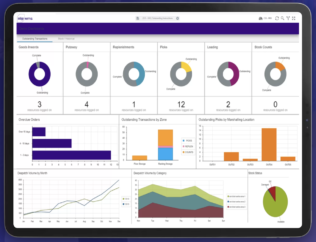-
ROSSLARE EUROPORT TARGETS HEALTH & SAFETY WITH CAMERA TELEMATICS PARTNERSHIP - 2 days ago
-
Landmark Study Reveals Wearable Robotics Significantly Boost Safety and Efficiency in Industrial Environments - July 24, 2024
-
Visku Tackle The Retail Seasonality Challenge One Pallet At A Time - July 22, 2024
-
KAMMAC AND BERGEN LOGISTICS STRENGTHEN FASHION & LIFESTYLE SERVICES IN THE UK - July 19, 2024
-
TENTBOX EXTENDS PARTNERSHIP WITH ARROWXL TO SUPPORT INCREASING DEMAND - July 17, 2024
-
The Perfume Shop improves customer journeys while driving profitability in partnership with Scurri - July 17, 2024
-
ZEROMISSION SECURES £2.3M ($3M) INVESTMENT TO ACCELERATE ELECTRIC FLEETS - July 16, 2024
-
BCMPA CELEBRATES SUCCESS OF 2024 CONFERENCE - July 15, 2024
-
Best of the Best: Jungheinrich Celebrates Triple International Award Win - July 12, 2024
-
GOPLASTICPALLETS.COM CALLS ON NEW CHANCELLOR RACHEL REEVES TO CONSIDER PLASTIC PACKAGING TAX REFORM - July 10, 2024
There is an old saying that applies equally wherever in the world you are running a business. The customer is basically always right. Americans say the ‘Customer is King’ and in the UK, being slightly more reserved, we talk about being ‘Customer Driven’. Germany has a more direct translation, der Kunde ist König and in France, le client n’a jamais tort or ‘the customer is never wrong’ is the general maxim. Japan takes customer appreciation a step further with the motto okyakusama wa kamisama desu, which means ‘the customer is a god’.
Customers and their requirements need to be front and centre in the thoughts of every business decision. What happens in the warehouse is no exception. Customer centricity is so important that it is driving the priority metrics being used to measure warehouse performance. Recent research published in the Warehousing Education and Research Council (WERC) DC Measures Report 2023 highlighted that the top 4 metrics were directly related to customer satisfaction. It’s not surprising given how much more demanding customers have become as a result of e-commerce. Competing brands are only a click away, timeliness and convenience is everything.
What are the top DC metrics?
Putting customers first
Right at the top are metrics that directly relate to ensuring customer satisfaction. According to the report’s authors, these measures indicate a noticeable shift at the top of 2023’s rankings, demonstrating an increased laser focus on customers. The new top four are all customer-facing measures and represent the different dimensions of another well known metric, the perfect order index. This is a score that many warehouses benchmark their performance against and it measures the four major components of a perfect order: delivering orders on-time, shipping them damage-free, complete and with correct documentation.
Typically companies with higher perfect order rates carry less inventory, experience shorter cash-to-cash cycle times, and have far fewer stockouts. Conversely imperfect orders lead to increased shipping labour costs, the need to provide replacement products, and lower revenue due to lost sales and customers.
Interestingly, being able to attain the perfect order index measure is only possible if the warehouse has full visibility of available stock and operational performance in real-time. This requires a level of automation that can be attained by implementing a warehouse management system WMS software solution. Using a WMS provides an instant overview of when orders were shipped against delivery targets and the immediate stock availability tracking functionality ensures that orders are either shipped complete, or customers are at least notified of any expected delays from the outset.
In a highly competitive e-commerce environment, where margins are ultra-thin and customers are swayed easily and free to shop around for alternatives, service is absolutely everything. The customer is always the king (or König) and any systems that can enable them to feel that way routinely when they buy from your company will help ensure your brand keeps its share of wallet and stays front of mind.
Author
Eric Carter, Solutions Architect at Indigo Software.
For more information about using Indigo WMS to track key metrics in your warehouse, contact Indigo Software.

































